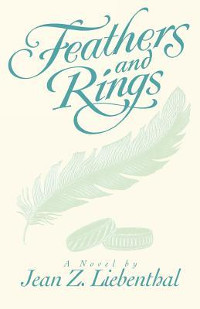Cottonwood Summer, by Jean Z. Liebenthal (Christian fiction, Latter-day Saint)
“When Nola and Beverly are forbidden to participate in the lake excursion, they can’t guess that their selected alternative will provide the biggest adventure in their young lives. Nothing less than a reform school escapee, in fact!”
Feathers and Rings, by Jean Z. Liebenthal (Christian fiction, Latter-day Saint)
“Nola is in love with Kent—but he hardly seems to notice her. Although she manages to have an occasional good time at the Saturday-night dances with her longtime neighbor Norman, Nola fears she may become an ‘old maid.'”
As I embarked on this project to comment on novels that give me a glimpse of Zion, I felt that, despite my love for the classics, this would be an unbalanced presentation if I neglected the fiction written by members of my own religion. I thought I would re-read a few of the books in this category that I actually own. Several years ago I gave quite a few Latter-day Saint novels away, needing the shelf space and knowing I wouldn’t re-read those particular works. For that reason, the books I own are ones I like a lot and have probably already re-read at least once.

At the top of that list is a novel entitled Feathers and Rings. I don’t think I’ve ever seen this obscure little book on anyone’s list of “Best Latter-day Saint Fiction,” but of all the Latter-day Saint novels I’ve sampled over the years, this is the one I keep going back to—I’ve read it at least four times now. I absolutely love this book! The language is lively, humorous, and unsentimental, and the characters have the feel of real people. The novel evokes a time, place, and community that feels authentic to me, as if I’m stepping back in time to southern Idaho in the mid-twentieth century and observing the way these good people really were, visualized through the eyes of a young woman coming of age.
Nola Borden, the daughter of a farmer, has just graduated from high school and can’t seem to get herself out the door to find a job. Her mother, exasperated, insists she go to town and apply at every office there. She is not to come home until she either finds a job or has applied everywhere. She suggests the bank first. Nola counters that even her math teacher told her that she shouldn’t be working with money. Here’s the way the scene in Chapter 2 finishes:
My employment up to this time had always consisted of purely physical labor. I was actually afraid of offices, and would rather have gone on cleaning houses and working in the fields.
“Maybe Mrs. Johnson could give me more hours,” I said.
“Then why did you take three years of typing and two of shorthand?”
“Because you made me,” I answered. “I wanted to take French instead, remember?”
“And then where would you have worked? Do you know of any stores where they speak French?”
She pushed her chair back and headed for the dishpan to wash her bowl. The conversation was finished.
The book is filled with down-to-earth scenes like this one. The theme revolves around discarding aspirations for artificial happiness and discovering what is real and wonderful in one’s own life. It reminds me of this quotation by one of the prophets of my church, President Gordon B. Hinckley:
“Seek for the real things, not the artificial. Seek for the everlasting truths, not the passing whim. Seek for the eternal things of God, not for that which is here today and gone tomorrow. Look to God and live.”
Teachings of Gordon B. Hinckley, p. 494

When I decided to re-read Feathers and Rings, I thought it would be nice to read Cottonwood Summer, which details a summer when the characters in Feathers and Rings were children, and so I bought a copy. It, too, is a keeper. Both of these books are out of print, so if you want to read them, you’ll have to borrow them or buy them from a store that sells used books.
While both of these books were published to members of The Church of Jesus Christ of Latter-day Saints, they don’t deal with religious themes at all. Almost all of the characters are Latter-day Saints and terms such as Relief Society, mission, and bishop are occasionally used without explanation, but you never see the characters in church and they don’t talk about religious ideas. In Cottonwood Summer, a young man gets baptized into the Church, but the baptism occurs off-stage. In the same book, a priesthood blessing is mentioned, but not detailed or discussed, and there is a brief reference to the fact that Nola is a descendant of a pioneer polygamist family. Because there is so little actual religious content in these books and the themes are universal, I believe the books would be accessible to a larger audience than they were originally published for.
The featured image came from Pixabay.



